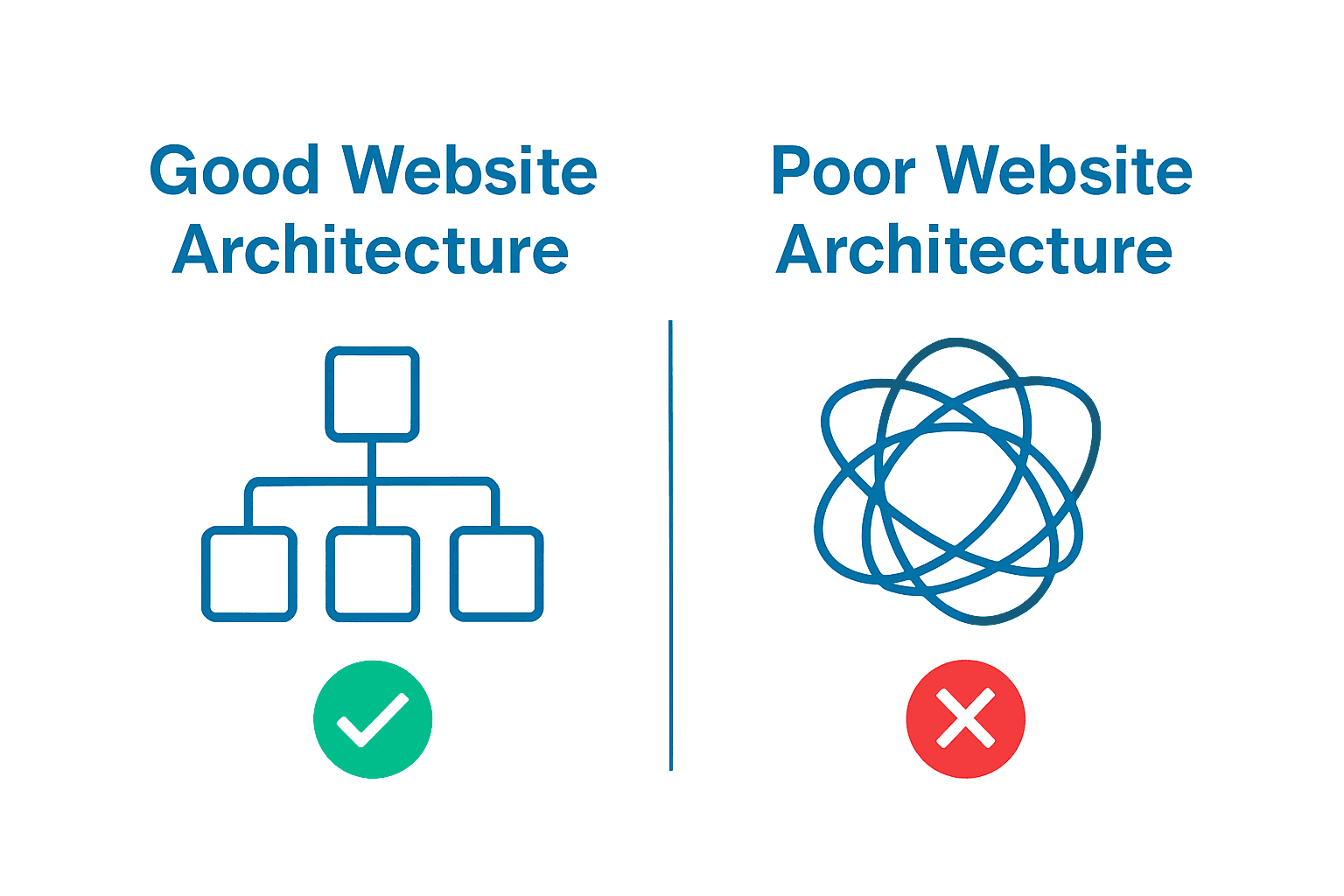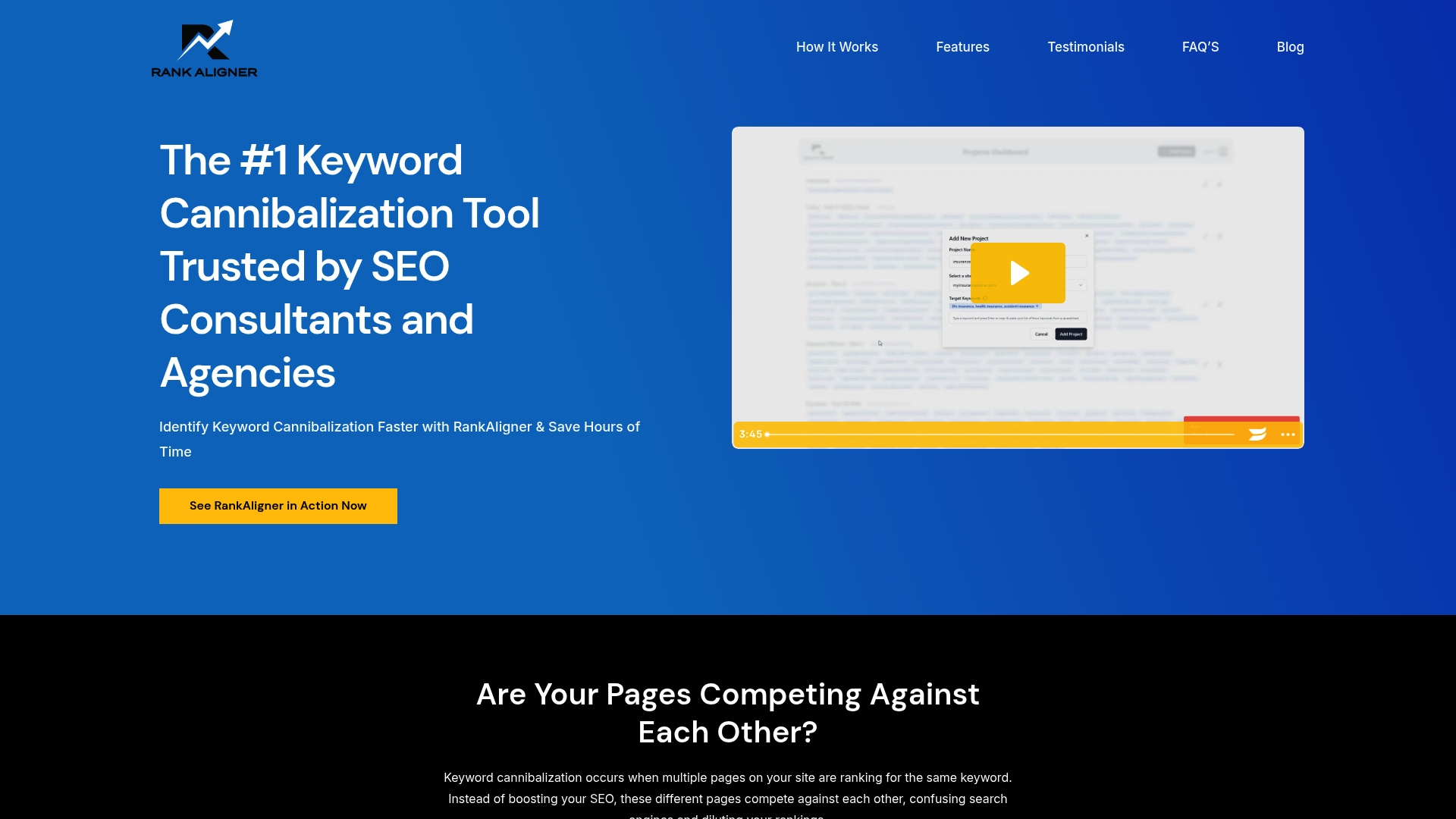Website architecture shapes how every piece of information connects and flows throughout a site and it is the key reason why some sites are easy to use and others feel impossible. Most people think website structure is just about how things look or where menus sit. The real secret is this: sites with clear structures can see up to 200 percent better crawl rates from search engines compared to messy ones. That changes everything for how you show up online.
Table of Contents
- What Is Website Architecture And Why It Matters
- Key Principles Of Effective Website Architecture
- How Website Structure Influences Seo And User Experience
- The Role Of Navigation In Website Architecture Best Practices
- Common Mistakes To Avoid In Website Architecture
Quick Summary
| Takeaway | Explanation |
|---|---|
| Effective architecture boosts SEO | A well-organized website helps search engines index content efficiently, improving search visibility. |
| Intuitive navigation enhances user experience | Clear navigational pathways reduce cognitive load, making it easier for users to find information. |
| Maintain a logical information hierarchy | Organizing content logically aligns with user expectations and facilitates better understanding. |
| Develop clean, descriptive URLs | Clean URLs communicate page content clearly, contributing to improved SEO and user comprehension. |
| Avoid complicated structures | Overly complex navigation can confuse users, leading to higher bounce rates and less engagement. |
What is Website Architecture and Why It Matters
Website architecture is the strategic blueprint that defines how digital content is organized, structured, and interconnected within a website. According to Mozilla’s developer documentation, it represents the foundational framework determining how users navigate and interact with online information.
The Strategic Framework of Website Design
At its core, website architecture encompasses more than just visual design. It involves creating a logical, intuitive system that enables seamless user experiences while supporting critical technical requirements. This architectural approach considers multiple dimensions:
- Information Hierarchy: Organizing content in a logical, easily comprehensible manner
- Navigation Pathways: Designing clear, efficient routes for users to access information
- Technical Performance: Ensuring smooth interactions between different website components
Website architecture directly influences how search engines understand and index digital content. A well-structured website enables search engine crawlers to efficiently map and rank pages, which significantly impacts organic search visibility.
Critical Components of Effective Website Architecture
Successful website architecture integrates several key elements that work together to create a robust digital environment. These include:
- URL Structure: Creating clean, descriptive URLs that communicate page content
- Internal Linking: Establishing meaningful connections between related pages
- Site Mapping: Developing a comprehensive overview of website content and relationships
Professional website architects understand that read more about technical SEO foundations requires balancing user experience with search engine optimization strategies. The goal is creating digital spaces that are both human-friendly and crawler-accessible, ensuring optimal performance across multiple platforms and devices.
Below is a table summarizing the critical components of effective website architecture, helping to clarify the role each element plays in overall site performance and SEO.
| Component | Description | Role in Architecture |
|---|---|---|
| URL Structure | Clean, descriptive URLs that communicate page content | Improves crawlability and user comprehension |
| Internal Linking | Connections between related pages | Establishes content relationships, boosts SEO |
| Site Mapping | Overview of all content and relationships | Guides crawler indexing and user navigation |
| Logical Hierarchy | Organizing content in an intuitive, logical manner | Aligns with user expectations |
| Responsive Design | Ensuring consistent performance across devices and platforms | Enhances usability and mobile SEO |
Key Principles of Effective Website Architecture
Effective website architecture requires strategic planning and implementation of core principles that ensure optimal performance, usability, and search engine compatibility. According to research from Nielsen Norman Group, successful information architecture goes beyond simple navigation and encompasses comprehensive user experience design.
Structural Integrity and User Experience
The fundamental principles of website architecture revolve around creating a cohesive, intuitive digital environment. This involves developing a framework that allows users to navigate complex information landscapes with minimal cognitive effort. Key considerations include:
- Logical Information Hierarchy: Organizing content in a manner that reflects user mental models
- Predictable Navigation: Creating consistent pathways that align with user expectations
- Scalable Design: Building flexible structures that can accommodate future content expansion
Professional web architects understand that structural design is not merely about aesthetics but about creating meaningful connections between different content elements. Semantic relationships between pages and sections play a crucial role in establishing a comprehensible digital ecosystem.
Technical Performance and Search Optimization
Beyond user experience, website architecture directly influences technical performance and search engine optimization. A well-constructed architecture enables efficient crawling, indexing, and ranking of web content. Learn more about technical SEO foundations to understand how architectural decisions impact digital visibility.
Effective website architecture requires balancing multiple technical considerations:
- Clean URL Structures: Developing descriptive, meaningful web addresses
- Efficient Internal Linking: Creating strategic connections between related content
- Responsive Design: Ensuring consistent performance across multiple devices and platforms
By prioritizing these architectural principles, websites can create robust digital experiences that serve both user needs and technical requirements, ultimately driving engagement and search performance.
How Website Structure Influences SEO and User Experience
Website structure serves as the critical foundation that simultaneously impacts both search engine performance and user interaction dynamics. According to Google’s Search Central documentation, the architectural design of a website plays a pivotal role in determining its visibility and accessibility.
Navigational Complexity and Search Engine Crawlability
The relationship between website structure and search engine optimization is intricate and multifaceted. Search engine crawlers rely on clear, logical site architectures to efficiently map and index digital content. A well-designed website structure enables these automated systems to:
- Understand Content Relationships: Recognize semantic connections between different pages
- Evaluate Page Hierarchy: Determine the relative importance of content sections
- Optimize Crawl Efficiency: Reduce barriers to comprehensive website exploration
When websites maintain clean, intuitive navigational pathways, they significantly enhance their potential for improved search rankings. Complex or convoluted structures can impede crawler accessibility, potentially reducing overall search visibility.

User Experience and Structural Engagement
Beyond technical optimization, website structure fundamentally shapes user interaction and engagement. Explore our guide on SEO and user experience synergy to understand the deeper connections between architectural design and digital interaction.
Effective website structures create seamless user journeys by:
- Reducing Cognitive Load: Minimizing user effort required to find information
- Establishing Intuitive Navigation: Creating predictable content discovery pathways
- Supporting Rapid Information Access: Enabling quick, efficient content retrieval
Professional web designers recognize that optimal website architecture balances technical requirements with human-centered design principles. By creating structures that serve both search engine algorithms and user expectations, websites can achieve superior performance and engagement metrics.
The Role of Navigation in Website Architecture Best Practices
Navigation represents the critical interface between website content and user interaction, serving as the primary mechanism through which visitors explore digital landscapes. According to W3C accessibility guidelines, effective navigation is fundamental to creating inclusive and user-friendly web experiences.
Structural Design and User Orientation
Navigation systems do far more than simply connecting web pages. They function as comprehensive wayfinding mechanisms that help users understand their current location, potential paths, and overall website context. Successful navigation design incorporates several key principles:
- Logical Hierarchy: Creating clear pathways that reflect content relationships
- Consistent Placement: Maintaining predictable navigation elements across pages
- Intuitive Labeling: Using clear, descriptive terminology that matches user expectations
Cognitive mapping plays a crucial role in navigation design. Users subconsciously build mental models of website structures, and intuitive navigation supports these internal representations by providing predictable, meaningful connections between different content sections.
Technical Considerations and SEO Impact
Navigation goes beyond visual design and directly influences technical performance and search engine optimization. Learn more about semantic HTML principles to understand how navigation structures contribute to overall website effectiveness.
Professional web architects recognize that navigation systems must balance multiple technical requirements:
- Crawlability: Enabling search engine bots to efficiently map website content
- Accessibility: Supporting diverse user interaction methods
- Performance: Minimizing loading times and computational complexity
By implementing strategic navigation architectures, websites can create seamless user experiences that simultaneously serve human visitors and search engine algorithms, ultimately driving engagement and digital performance.

Common Mistakes to Avoid in Website Architecture
Website architecture failures can significantly undermine digital performance and user experience, creating substantial barriers to effective online engagement. According to Google Search Central, understanding and avoiding common architectural pitfalls is crucial for maintaining robust digital platforms.
Structural and Navigational Errors
Many website architecture mistakes stem from poorly conceived structural designs that impede user interaction and search engine comprehension. These fundamental errors often manifest through:
- Overcomplicated Navigation: Creating multi-layered menus that confuse users
- Inconsistent URL Structures: Developing unpredictable or non-descriptive web addresses
- Inadequate Internal Linking: Failing to establish meaningful connections between related content
Complexity is the enemy of effective website design. When navigation becomes convoluted, users struggle to find information, leading to increased bounce rates and diminished engagement. Professional web architects understand that simplicity and clarity are paramount in creating intuitive digital experiences.
Technical Performance and SEO Vulnerabilities
Technical architecture mistakes can severely compromise a website’s search engine visibility and overall performance. Learn more about critical SEO mistakes to avoid to understand the potential long-term consequences of architectural missteps.
Critical technical errors that undermine website architecture include:
- Poor Mobile Responsiveness: Failing to create adaptable design across devices
- Slow Page Loading: Implementing complex structures that increase computational overhead
- Improper Heading Hierarchies: Misusing HTML structural elements
By recognizing and proactively addressing these common architectural mistakes, websites can create more robust, user-friendly, and search engine optimized digital environments that effectively serve both human visitors and automated crawlers.
This table outlines common website architecture mistakes and their associated consequences, making it easier to spot and avoid these critical errors during design and optimization.
| Mistake | Description | Negative Outcome |
|---|---|---|
| Overcomplicated Navigation | Multi-layered menus or unclear pathways | User confusion, higher bounce rates |
| Inconsistent URL Structures | Unpredictable, non-descriptive web addresses | Poor SEO, difficult content tracking |
| Poor Internal Linking | Failing to connect related pages meaningfully | Weak SEO, missed ranking potential |
| Lack of Mobile Responsiveness | Design not adapting to various devices | Reduced engagement, lower SEO rank |
| Slow Page Loading | Heavy or complex structures slow website performance | Lower rankings, poor user experience |
| Improper Heading Hierarchies | Misuse of HTML structure (headings out of order) | Confused crawlers, weaker SEO |
Transform Confusing Website Architecture into Clear SEO Success
Have you ever struggled with a website that just feels tangled? Poor structure, confusing navigation, and weak internal linking can cause frustration for both users and search engines. When your website architecture is unclear, not only do visitors leave quickly, but your pages might also fight for the same keywords. This kind of keyword cannibalization is a common pain point mentioned in discussions about missed rankings and lack of visibility, directly affecting your optimization goals.

Take control of your website’s performance right now by making your architecture understandable for users and search engines alike. The #1 Keyword Cannibalization Tool helps you eliminate structural issues and ensure every page stands out. Let our platform show you exactly where problems lie so you can optimize your internal linking and hierarchy immediately. If you want your website to deliver both great user experiences and top search results, visit RankAligner and start building a clearer, more effective site structure today. Act now before hidden site issues lock you out of SEO growth.
Frequently Asked Questions
What is website architecture?
Website architecture refers to the strategic blueprint that defines how content is organized, structured, and interconnected on a website, impacting user navigation and search engine indexing.
Why is website architecture important for SEO?
A well-structured website architecture enhances search engine crawlers’ ability to efficiently map, index, and rank web content, significantly improving organic search visibility and performance.
What are the key components of effective website architecture?
Key components include logical information hierarchy, clean URL structures, efficient internal linking, and responsive design to support optimal user experience and search optimization.
How does navigation affect website architecture?
Navigation serves as a critical interface for user interactions, and effective navigation design promotes a logical information hierarchy, predictable pathways, and overall website context, enhancing both user experience and search engine accessibility.
Recommended
- Understanding Technical SEO for Beginners Made Simple – Rank Aligner – Your Ultimate Keyword Cannibalization Problem Solver
- Website Conversion Strategies for More Leads | Rank Aligner
- What is Technical SEO? & Why Its Very Important for SEO
- Semantic HTML for SEO: Key Elements & Applications | Rank Aligner

